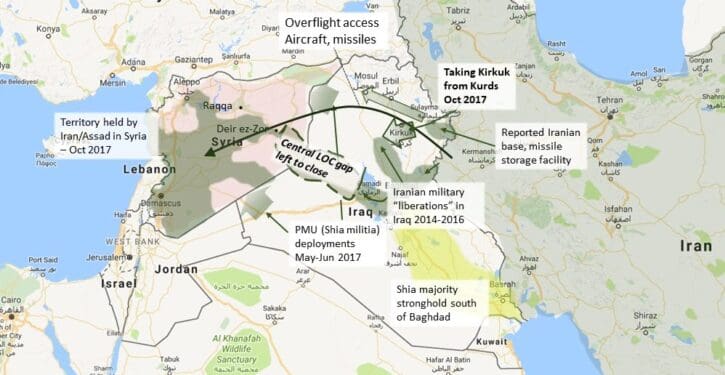
The New York Times had a funny headline for a funny article on Wednesday. The humor lies in the fact that a Trump policy, undertaken for multiple reasons – not all of which NYT approves – is producing an outcome NYT favors.
NYT favors enabling Iran. But Trump doing it poses editorial challenges. So the editors managed to squeeze out a slight jab at Trump, while keeping it muted and recounting events with a carefully straight face. Just another eyebrow-raising development in a time of quizzical grimaces.
Trump is enabling Iran to take effective ownership of Iraq, by overtly standing aside and letting Iran broker and direct a forced retreat of the Kurds in northern Iraq. It is useless to pretend this isn’t happening, when Qods Force commander Qassem Soleimani was in the Kirkuk region when the “battle” for Kirkuk started on Sunday 15 October, and reportedly brokered a deal with the PUK Kurdish faction to retreat from Kirkuk, while Soleimani’s sidekick combat leaders and Iranian-backed militia units were moving in on Kurdish positions. (See here and here as well.)
As with the campaign to drive ISIS from Iraq (Tikrit, Ramadi, Fallujah, Mosul), the central government in Baghdad continues to be decisively indebted to Iran for dislodging “insurgents” – the Kurds, in this case – from areas of Iraqi territory.
The “ownership” effect for Iran is even greater in this case, because Soleimani has credit for orchestrating the deal with the PUK.
He didn’t do that for Baghdad. He did it for Tehran. Iran doesn’t want to break up Iraq’s territory; Iran wants to have de facto control of all of it.
If there’s no viable future for independent Kurds, northern Iraq will be gradually turned by some negotiated mechanism into Tame Kurdsville, to Iran’s benefit.
It doesn’t matter how permanent that is; what matters is how it will transform the landscape while it’s the reality.
Russia will make sure to be in the middle of it (someone has to broker between Iran and Turkey) – a position Moscow’s leaders have coveted for centuries. This condition, once established, will not go away, probably ever. The impact of it on Russia’s ability to affect everything between the Caucasus and the headwaters of the Danube cannot be overstated.
The intact Iraq preferred by the U.S. national security leadership will be a wholly-owned subsidiary of Tehran. Pretending it’s not will be a booming business with a costly bill coming due.
The conundrum for the U.S.
There were no magic personnel pills to avert this turning point. Steve Bannon, if he hadn’t left the White House, would presumably still advocate against the U.S. intervening.
I suspect Sebastian Gorka would say there is no feasible way for the U.S. to take patronage of a Kurdish independence bid. It would mean a level of exertion – not in combat; not for our ground troops; but in terms of strategy and diplomacy – that no doubt looks very large and disruptive.
There has been a persistent, low-level sentiment for Kurdish independence under some arrangement for nearly 100 years, but the time for it never seems right. It would be formally bucking the status quo, at any time, to take it on as an affirmative enterprise of U.S. policy. It could be seen as an especially untimely challenge in 2017, when the principle of borders and nation-state integrity is under assault worldwide in important, destabilizing ways.
I don’t think the advisory team of Bannon and Gorka would have opposed the mainliners – Tillerson, McMaster, Mattis – on this.
I do think Michael Flynn would have seen very clearly what Iran is doing, and wouldn’t have let it go.
He’d be right not to. It is the opposite of stabilizing and benign, for Iran to encroach on Iraq to the extent she has been suffered to. If Iran is going to own Iraq, for practicalities like flying troops and war materiel across Iraqi airspace to Syria, and directing the activities of armed militias on Iraqi soil, it really is lying to ourselves in a most dangerous manner, to pretend that an intact Iraq is better than a partitioned one.
Under these circumstances, an intact Iraq is a great boon for Iran’s campaign to consolidate a land bridge to the Mediterranean. Looking at borders and formal arrangements, instead of at what’s going on within and under them, isn’t wisdom; it’s stupidity.


Meanwhile, our ability to hold Iran at risk in feasible, useful ways is severely compromised by the effective expansion of Iranian territory to include Iraq. Geography is central, not incidental, to putting pressure on the mullahs’ regime.
Thwarting Iran on her western frontier – the push through Iraq into Syria – is a core element of thwarting Iran, period. The latter can’t be done without the former. Yet instead of pushing back on Iran’s west-bound campaign of territorial enlargement, we are rolling out a red carpet for it.
What will the neighbors think?
There is no certainty to any timeline-specific prediction about what the Arabs or the Turks will do. They’ll want to push back, but for as long as possible they’ll resist upending the status quo themselves, if that’s necessary to do it.
I think of Turkey as more of a wild card, because of her very direct concerns about the geomilitary movements of everyone involved: Iran, the Kurds, Russia. Turkey is directly affected, and in more than one dimension, by each of them. Add to that the growing extremism inside Turkey, and the neo-Ottoman vision of Erdogan, and the mix is volatile.
Turkey has a very large army, and geographic advantages that make it inadvisable to engage in combat with her lightly. Turkey has been relatively quiet up to now, but the way to wake her up is to suffer Iran to edge closer and closer to her southeastern border with Iraq behind a network of agreements with Kurds. Russia bustling about holding a briefcase in one hand and air defense radars in the other serves to pour gasoline on the flames.
(Don’t assume, by the way, that a Turkey on the move will choose to move east. Or move in an obvious, linear fashion, for that matter. We’re back in a world in which moving west to empower oneself to the east is an intelligent strategy; and there’s more than one way to do it. Society and politics in the Balkans and Germany are productive lines of effort, but if I were Turkey, I’d be all over Italy and Libya right now.)
We can expect the Arabs in Saudi Arabia, Jordan, and Egypt to continue favoring pushback, and quietly applauding it where it occurs. We can also expect them to become instantly – albeit temporarily – adaptable if it appears advantageous down the road. No matter when such a watershed occurs, the main things they will be doing under any circumstances are arming themselves, suppressing inconvenient insurgents, and expanding their base of relationships with outside powers.
Israel continues to point out that she can’t sit still for completion of the Iranian land bridge. I’m not sure those who favor the intact-Iraq priority have really thought about where Israel will have to fight, if she is compelled to preempt an Iranian posture building against her. It isn’t 1967 anymore. No fight of this kind will be limited to the Golan Heights, southern Lebanon, or the Jordan River Valley – because an Iran maneuvering in phased campaign steps for a conventional attack can reach further than that, to wage the tactical fight, from every axis.


It’s not only the territorial scope of immediate, last-ditch preemption that is enlarged by the technology of war today. The territorial scope of strategic prevention, both before and after a live preemptive engagement, is enlarged too. (“Strategic” does not mean “nuclear” here. It means the whole set of national-power precautions to deter a first attack – or a subsequent one. Non-nuclear examples from the past would include occupying the Sinai Peninsula, demilitarizing the Sinai in order to cede it back to Egypt, and occupying the Golan Heights. There are examples too numerous to count from other situations in Western history.) Just think about it, if you haven’t already.
If we want an intact Iraq, the price of having one without fostering long-term strife across the Middle East is pushing Iran back out of Iraq. It is not a wise choice to actively do the opposite.



